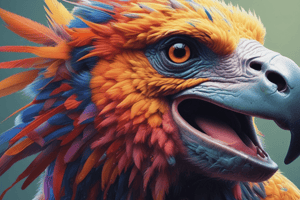Podcast
Questions and Answers
¿Cuál de las siguientes afirmaciones es cierta sobre la evolución divergente?
¿Cuál de las siguientes afirmaciones es cierta sobre la evolución divergente?
- No influye el proceso de selección natural.
- Ocurre en especies que comparten un ancestro común. (correct)
- Produce siempre especies que son idénticas en comportamiento.
- Resulta en estructuras adaptativas similares entre diferentes especies.
¿Cuál es un ejemplo clásico de evolución convergente?
¿Cuál es un ejemplo clásico de evolución convergente?
- Los cambios en el pelaje de las especies en climas fríos.
- La evolución de diferentes especies de mamíferos a partir de un ancestro común.
- La adaptación de las alas en aves y murciélagos. (correct)
- La diferencia entre los extremos de las extremidades de las ballenas y los humanos.
¿Qué factor es clave para la divergencia de las poblaciones en la evolución divergente?
¿Qué factor es clave para la divergencia de las poblaciones en la evolución divergente?
- La existencia de un ancestro común.
- La similitud en el hábitat.
- El cambio aleatorio en las frecuencias génicas. (correct)
- La interacción entre especies.
La evolución de las aletas en tiburones y delfines es un ejemplo de:
La evolución de las aletas en tiburones y delfines es un ejemplo de:
¿Qué sucede a menudo como resultado de la divergencia evolutiva en las especies?
¿Qué sucede a menudo como resultado de la divergencia evolutiva en las especies?
¿Cuál de las siguientes no es una característica de la evolución convergente?
¿Cuál de las siguientes no es una característica de la evolución convergente?
¿Qué rol desempeñan las presiones selectivas en la evolución convergente?
¿Qué rol desempeñan las presiones selectivas en la evolución convergente?
¿Cuál de las siguientes afirmaciones es incorrecta sobre las extremidades de los murciélagos, ballenas y humanos?
¿Cuál de las siguientes afirmaciones es incorrecta sobre las extremidades de los murciélagos, ballenas y humanos?
Un resultado de la selección natural en la evolución divergente es:
Un resultado de la selección natural en la evolución divergente es:
Flashcards
Evolución Divergente
Evolución Divergente
Proceso donde dos o más especies con un ancestro común se vuelven más diferentes con el tiempo, adaptándose a entornos y nichos ecológicos distintos.
Evolución Convergente
Evolución Convergente
Desarrollo independiente de características similares en especies no emparentadas recientemente, debido a presiones ambientales similares.
Adaptación
Adaptación
Característica que aumenta la supervivencia y reproducción de un organismo en su ambiente.
Nicho Ecológico
Nicho Ecológico
Signup and view all the flashcards
Ancestro Común
Ancestro Común
Signup and view all the flashcards
¿Por qué evolucionan las alas en las aves y los insectos?
¿Por qué evolucionan las alas en las aves y los insectos?
Signup and view all the flashcards
Función de las extremidades anteriores
Función de las extremidades anteriores
Signup and view all the flashcards
Influencias de la evolución divergente
Influencias de la evolución divergente
Signup and view all the flashcards
Rasgos convergentes en organismos diferentes
Rasgos convergentes en organismos diferentes
Signup and view all the flashcards
Cambios en el mismo gen
Cambios en el mismo gen
Signup and view all the flashcards
Study Notes
Divergent Evolution
- Divergent evolution is the process where two or more species sharing a common ancestor become more different over time.
- This often results from adaptation to different environments and ecological niches.
- The accumulating differences in traits lead to the formation of new species.
- An example is the evolution of different mammal species from a common ancestor. The forelimbs of bats, whales, and humans, for instance, share a basic structure but have adapted to perform different functions (flying, swimming, manipulating objects).
- Genetic drift and natural selection play key roles in driving divergent evolution. Genetic drift can lead to random changes in gene frequencies within populations separated from each other. Natural selection favors traits that provide an advantage in a specific environment, causing populations to diverge.
- Modifications to the same underlying gene can result in divergent traits. Over time, these differences can be substantial, and species may develop anatomical, physiological, and behavioral adaptations that distinguish them significantly from their common ancestor.
Convergent Evolution
- Convergent evolution is the independent development of similar traits in two or more species that do not share a recent common ancestor.
- This occurs when different organisms face similar environmental challenges and selective pressures.
- The common selective pressures result in the evolution of similar adaptations in unrelated lineages.
- Examples include the evolution of wings in both birds and insects. Despite different evolutionary origins, both groups have developed wings that allow them to fly. Another example is the streamlined body shape found in sharks and dolphins, both adapted for aquatic life.
- Convergent evolution can lead to remarkable anatomical similarities between distantly related organisms.
- The evolution of similar solutions to similar challenges suggests that certain adaptations can be highly effective and are favored by natural selection, irrespective of ancestral lineages.
- Often, convergent traits evolve through similar genetic pathways or through adaptations from pre-existing structures.
Studying That Suits You
Use AI to generate personalized quizzes and flashcards to suit your learning preferences.




